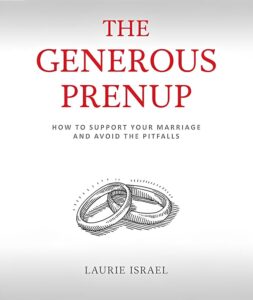By Laurie Israel
I’m a prenup attorney and mediator. After a long law career that included divorce, estate planning, tax law, and other related fields, somehow, I got interested in prenups. I personally don’t have one, and very few of my friends or relatives have one. Having said that, interestingly my practice led me helping people come to terms – mostly financial – with how they will address the financial aspects of their upcoming marriage. In doing so, I do help people put such a plan into a contract that is legally binding. That’s really what a prenup is – a legally binding contract about the financial aspects of marriage.

The reason I got into this field is that as counsel for people entering into prenups, I know just how stressful the process can be for most people. The word stressful is truly an understatement. Distressing is more like it to describe the feeling that is created when two people (usually through their lawyers as their microphones) try to negotiate the financial terms of their marriage in an adversarial format. Other words that aptly describe what prenup clients go through are “suffering,” “agony,” “misery,” and “anguish.” You get the picture.
With this typical scenario, it seemed to me like the marriage was starting in a damaged state actually caused by the prenup process. The process usually became an exercise in how little one spouse can provide, and how much the other spouse can obtain. It’s a lose-lose situation. Not a good way to begin a marriage. (Spoiler alert – if you think you need a prenup, try mediation first.)
But there can be positive aspects of the prenup process. One of them is talking about finances, financial goals and expectations. Another is sharing information about each of your financial pictures – assets, debts, explanation of debts, family money and expectancies of inheritance. Full disclosure is very important in prenups, but full disclosure may be had by couples without getting a prenup.
Planning “rules” and decisions about finances, looking at the potentially long term of a marriage is a different issue. Things change – a lot – in a 40- or 50- year relationship. It is imprudent to think that you can make good decisions now that will still be appropriate years down the road (and will be legally enforceable) but that’s just what prenups do. They are fixed and binding, and have the downside of undesirably changing marital behavior. Because a prenup is legally binding, when they (or some of the terms in the prenup) no longer have “vitality,” they are unchangeable, unless both parties agree to change them. As you can imagine, this can lead to bad feelings, and even divorce.
Is there an alternative to a legally binding full-blown prenup? Yes, there is. I call it a “Prenup Lite.”
What is a “Prenup Lite”? Well, in certain respects it’s the same as a binding prenup, except that it is aspirational, and is not signed with the formalities of a prenuptial agreement. In fact, it may not need to be signed at all. I think this especially can work well for first marriages of relatively young people. (It’s not as appropriate for “gray” prenups for second marriages, where sometimes a prenup can help the marriage and is necessary.)
Here are the steps to get a “Prenup Lite”:
- The future spouses get together and work together on their respective financial disclosures so that they are complete and accurate. It’s a good idea to share tax returns, recent asset statements, as well as statements of debts, and the reason for the debts.
- If a spouse is engaged in an active business, discuss what happens when money is earned (or lost) by the business, and what happens to the ownership and running of the business if the marriage ends. Same questions for a family business, whether a spouse is an active participant or not.
- Family wealth and expectancies (what a person might inherit) are very important to understand when planning for the future of the marriage. They are eventualities that cannot be ignored.
- If there are family trusts, it’s important to get copies of the actual trust document, find out the asset values, trustees, etc., and truly understand the terms of the trust whereupon one of the spouses might receive money in the future. For this, a mutual discussion with an estate planning attorney (maybe the one who drew up the trust) or with a lawyer/mediator with knowledge of estate planning would be important.
- In the case of marital financial planning for the future, it is very helpful to work with a lawyer/mediator who has experience in divorce law and prenups. You can discuss ideas and raise questions with each other and the mediator to get a “reality check” for how a potential decision might work out in the “real time” of a long-term marriage.
- The final step may merely be having achieved an increased understanding of each other’s finances and creating a tentative plan for the future. After the process, the couple can decide to sign a “Memorandum of Understanding.” This is not a legally binding document, but just an expression of intent – intent now, because things might change in the future. It should include the reasons behind the (tentative) financial decisions you come to and what was considered in making those decisions.
Yes, you will be losing certain “protections” by not having a legally binding prenup. Among those lost are inheritance requirements. (People can change their wills and disinherit a spouse in the last days of a long marriage.) Another loss is the alternative dispute resolution clause that keeps you out of court by requiring mediation, collaborative law, and finally, binding arbitration if there is a dispute if the marriage ends in divorce, or between a spouse and the heirs of the other spouse if the marriage ends in death.
But most divorce cases do not end in full-blown litigation, or even any litigation. Litigated divorces are very rare. Most people are civil and treat each other fairly throughout their marriage (which is why maybe a prenup is not such a good idea), even if the marriage ends in divorce.
So before making the decision to have a prenup, consider the option of having a “Prenup Lite.” It is a great way to promote honest conversations about all the facets of your upcoming marriage, even the ones you may have never even thought to consider, without committing yourself to a plan that you’re stuck with years down the road.
As published on mediate.com 4/22/24
©2024 Laurie Israel. All rights reserved.

Published in a slightly different version on mediate.com on February 7, 2024.
© 2024. Laurie Israel. All rights reserved.
